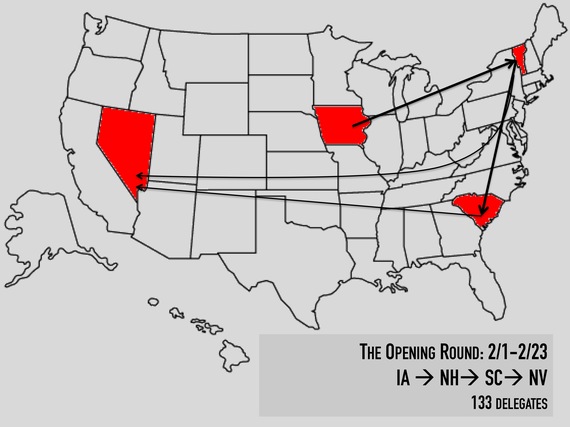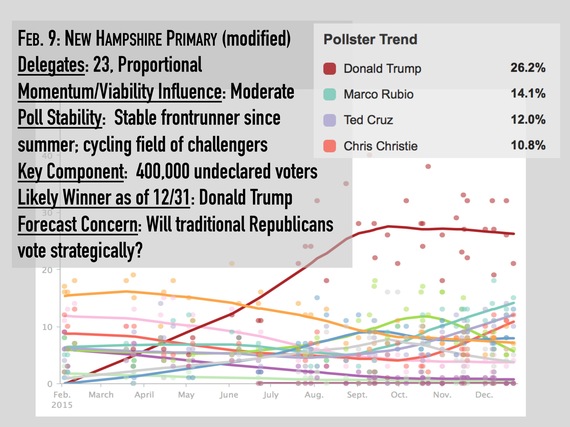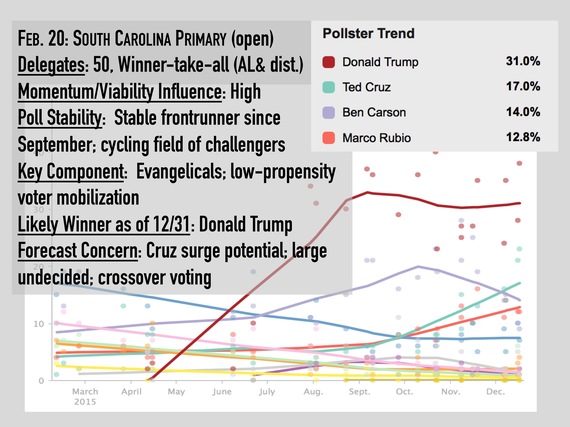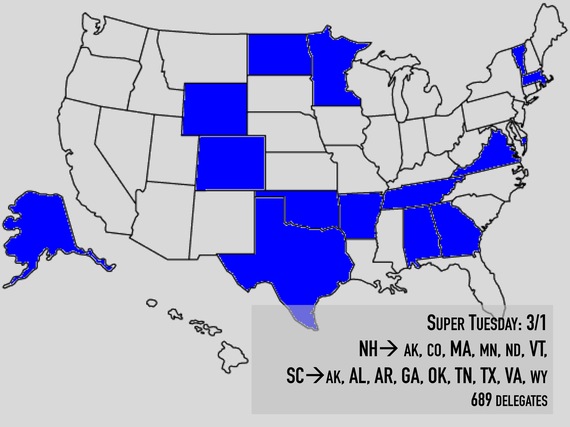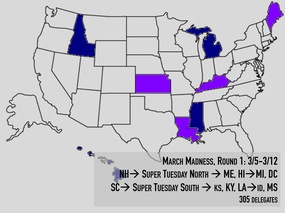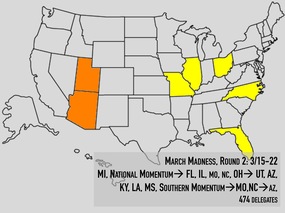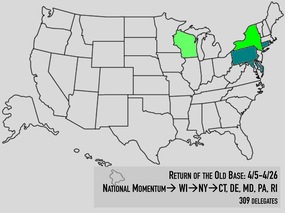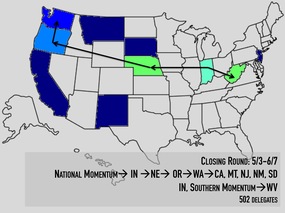On February 1, 2016 the first presidential nominating delegates will be selected, in Iowa. Iowa is the first of the 'trinity' events that start the actual campaign, along with New Hampshire and South Carolina. And, much like the celery, onion and peppers of south Louisiana cuisine, each contributes something to the base but also influences everything that comes after.
The Importance of the Trinity. Early primaries matter because they establish campaign momentum. The media speaks of Iowa and New Hampshire in hushed tones, and the voters themselves take their first in the nation status most seriously. But, as any South Carolinian will tell you, they are the most consistent bellwether of the Reagan Era. As the information in Figure 1 shows, of the last six open GOP nominations, Iowa correctly picked two winners, New Hampshire four and South Carolina five.

Efforts by data scientists to model the primary nomination process find that there are four variables that matter: money, homestate advantage, momentum and viability. Since 2008 spending has started to level off as a factor for candidates. Because of the emergence of SuperPACs, candidates are able to maintain financial support even in the absence of campaign success. But momentum -- the boost of a recent victory -- and viability -- the perception that one can win -- still remain as important influences on the outcome. Wins begat wins, and wins begat delegates. And delegates begat the perception of viability. Both momentum and viability feed media coverage. So, a process that allows a candidate to periodically win, and to accrue delegates along the way, keeps candidates in contention and also garners them free media.
So the Trinity matters because it creates an early opportunity to seize momentum, demonstrate viability and garner media attention. This winter, in the course of three weeks, four opportunities will present themselves between February 1 and February 23 -- the Trinity, followed by the Nevada caucuses.
The Celery. Each event in the Trinity offers a very different dynamic. Iowa, on February 1, is a closed party caucus. Participants have to be Republicans, and have to commit several hours to the process of making their vote count and placing their candidate over the top under the caucus's arcane rules. Only 30 delegates are at stake, and a proportionality rule is at work -- no one will sweep Iowa. This state has shown no consistent leader since November. Trump, Cruz and Rubio are all climbing but none is commanding overwhelming support. Cruz looks to be a likely winner at present because of his strong evangelical appeal. Evangelical Christians have had periodic, out-of-scale impact in Iowa since as early as the 1980 election, and in 1988 they placed Pat Robertson ahead of a sitting vice-president in the caucuses. The great unknown of Iowa is modeling the turnout. While Donald Trump polls strong, placing a powerful likely voter screen on the polls substantially trims his support. Are low propensity voters who want simple solutions willing to sit through the caucuses for Trump? If Trump performs poorly in Iowa, previous history says he will have to quickly establish momentum and assert viability in either New Hampshire or South Carolina.
The Onions. Eight days later comes New Hampshire, with a very different electorate and very different rules. Iowa was a closed Republican event that demanded substantial commitment to participate. By contrast, New Hampshire's primary is open to independent voters -- and there are 400,000 of them in the Granite State. Winning here makes a more substantial contribution to momentum, especially in the northeast and the west. As of December 31, Trump was still the frontrunner in New Hampshire and has been since September. But the second tier of candidates is nonetheless pulling significant amounts of the vote, and there is also a sizeable undecided. Every candidate has an incentive to do well here, and it is possible to establish momentum out of New Hampshire without winning. The question for the myriad supporters of the second tier candidates is, will they step back from a candidate they might well have met, in order to vote strategically against Trump or Cruz?
The Peppers. Eleven days later comes South Carolina. South Carolina is the key to the South. With the exception of Newt Gingrich in 2012, the Republican who wins South Carolina runs the table across Dixie. As in Iowa and New Hampshire, South Carolina is a heavily white GOP electorate. Evangelicals are even more prominent in Palmetto state politics than in Iowa. And, it is a winner-take-all event. So the momentum benefits of South Carolina are substantial. But it is also an open primary state, inviting nonpartisans into the primary. Trump has been holding at about a third of the GOP primary vote for months, while the other potential contenders cycle in and out of second place. The most recent rise is by Ted Cruz, who is the most viable opponent to Trump based on his appeal to evangelical Christians.
What Comes Next? If we were to map out the momentum flows of the campaign after South Carolina, the flow of momentum would initially favor a candidate with momentum and viability in general, and an evangelical appeal or an appeal to cultural conservatism and nationalism in particular. Ten days after South Carolina is Super Tuesday (March 1), with 689 delegates largely coming from Dixie. South Carolina is a historically strong predictor of the outcome of all these states.
Then, between March 5 and March 12, three more poor southern states with strong white nationalist sentiment and large evangelical electorates pick delegates.Also very conservative Kansas and Idaho will be weighing in. The big prize is Michigan, which could be good Trump territory. There are 305 delegates at stake across these states.
The balance of the campaign then continues in three waves. The last two southern megastates (Florida and North Carolina) vote on March 15 along with Ohio, Illinois and Missouri (474 delegates in all). Then, the balance of the campaign turns to the Northeast (with Wisconsin, 309 delegates), and then finishes with a month of contests that more increasingly toward the Pacific Coast primaries to close the campaign, and picking 502 delegates.
What We Are Seeing, and Why We Are Seeing It. We are already deep into the presidential nominating campaign. The invisible primary has been unusually visible this election, with multiple televised debate-events feeding the public a steady stream of content. And, in the highly visible invisible primary, we've seen both war strategies and marketing strategies being deployed by candidates. The campaign is particularly abrasive due to the combination of style and strategy.
The prospect of a brokered convention goes down if the front-running candidate coming out of Super Tuesday continues to win. The early primaries are largely proportional delegate contests. But, after Super Tuesday, the contests are largely winner-take-all. If the frontrunner establishes momentum, and has a sizeable delegate lead over any other challenger, then the nomination can be sewn up rather quickly. This assumes that an 'anybody but' campaign does not emerge where all the other contenders but one or two drop out to allow an establishment candidate (read: Rubio) to go head to head against the more abrasive potential frontrunner (Trump or Cruz).
War strategies are adversarial. In war strategies, candidates position themselves as a frontrunner, or as the most viable alternative, while relegating other candidates to the back of the pack. In 2012, the war strategy produced one constant Republican contender (Romney) and a cycle of alternative contenders who rose, challenged and fell back amongst the also-rans. No war strategies emerged among candidates until Donald Trump entered the campaign. His entry and rise in the polls gave the campaign both shape and a candidate sufficiently assertive to engage in an aggressive war strategy as frontrunner. Much like adolescent boys playing 'king of the hill,' the GOP field charges at the frontrunner, who taunts any contender climbing the polls. As a result, other GOP contenders find themselves simultaneously positioning against Trump and also the presumptive Democratic nominee.
But the invisible primary campaign has also contained lots of substantive positioning. There are critical issues that divide Republicans from Democrats, and also among each other. Unfortunately for the field of veteran candidates, they are trying position on issues to capture targeted voter groups while the frontrunner attacks everyone on every issue. Trump's war strategy is so aggressive and often so personal in its attacks that it turns all issue discussions into Trump discussions. And, in the process, it has made potential voting blocs such as segregationists and xenophobes a subject of active conversation in the campaign.
Trump's posture is unusual because, for lack of a better way to put it, it is not in the manner of front-runners. GOP voters have not seen a frontrunner who went aggressively negative. Audrey Haynes at University of Georgia observes that front-runners "rarely go negative" and do so only if confronting an opponent "who is rising substantially in the polls." And, Bernie Grofman notes that frontrunner attacks are usually provoked -- Trump's attacks have been ceaseless and are largely a function of his campaign style.
The result is a campaign environment where we are still sorting out contenders (there are a dozen contenders still in the game as of December 31) and therefore the events of the early primaries are both uncertain. This is both fun from a gamesmanship standpoint, but also creates great uncertainty about how momentum and viability will be captured by the remaining contenders.
This article previously incorrectly stated Reagan won Iowa in 1980. It has been corrected to show that Bush won the state.
